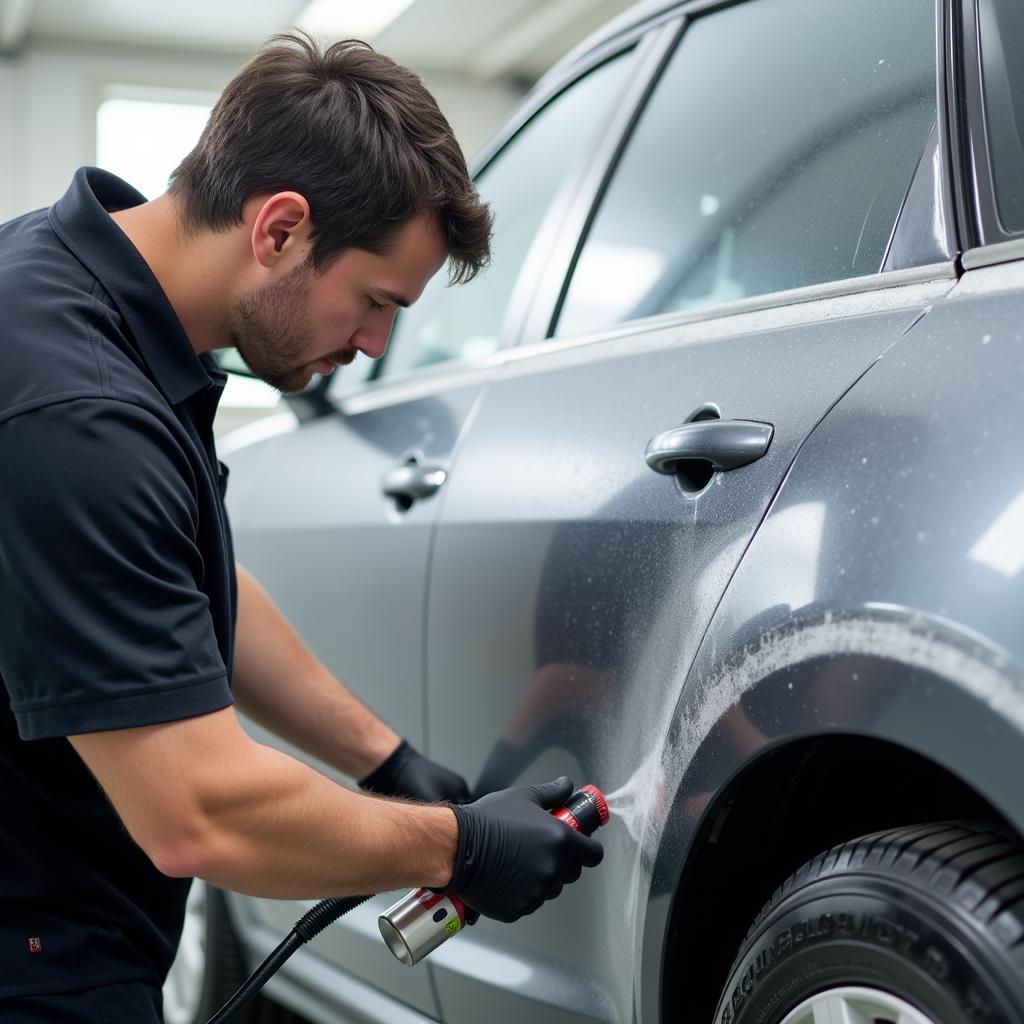Fisheye on car paint repair is a common defect that can mar the otherwise flawless finish of your vehicle. This frustrating issue appears as small, circular blemishes resembling the eye of a fish, hence the name. Understanding its causes, prevention, and effective repair methods is crucial for maintaining your car’s pristine appearance.
What Causes Fisheye in Car Paint?
Fisheye occurs when contaminants, usually silicone-based products, repel the freshly applied paint, preventing it from adhering properly to the surface. These contaminants create small craters or dimples where the paint pulls away, resulting in the characteristic fisheye appearance. Common culprits include waxes, polishes, tire shine, and even some hand lotions or aerosols. Even tiny amounts of these substances can cause significant problems. Another less common cause can be improper surface preparation, where remnants of old paint or cleaning solutions interfere with the new paint application.
Preventing Fisheye During Car Paint Repair
Prevention is always better than cure, and this holds especially true for fisheye. Meticulous preparation is key. Thoroughly cleaning the surface to be painted is the first line of defense. Use a dedicated automotive degreaser designed to remove silicone and other contaminants. Avoid using generic household cleaners as they may contain silicone. Wearing clean, lint-free gloves is also crucial to avoid transferring contaminants from your hands. Ensure the painting environment is clean and free from airborne contaminants like dust and overspray.
How to Fix Fisheye in Car Paint
If fisheye does appear, there are a few methods to address the issue. For minor cases, sanding down the affected area and reapplying the paint can be sufficient. However, for more severe cases, a complete stripping and repainting of the panel might be necessary. Fisheye eliminator additives can also be used in the paint mixture to help prevent the issue from reoccurring. These additives help break down the surface tension caused by the contaminants, allowing the paint to flow evenly.
“When dealing with fisheye, it’s always better to err on the side of caution,” says Johnathan Miller, Lead Auto Body Technician at Precision Autoworks. “Thorough surface preparation and the use of a quality fisheye eliminator can save you a lot of time and headache in the long run.”
Choosing the Right Fisheye Eliminator
Not all fisheye eliminators are created equal. Choose a product specifically designed for automotive paint and follow the manufacturer’s instructions carefully. Some products require mixing directly into the paint, while others can be sprayed onto the surface before painting.
Identifying and Addressing Underlying Issues
Sometimes, persistent fisheye can indicate a deeper problem, such as contaminated air lines or spray equipment. If you’re consistently experiencing fisheye despite proper preparation and the use of an eliminator, it’s crucial to inspect your equipment thoroughly.
“Contaminated airlines are a surprisingly common cause of recurring fisheye,” explains Sarah Chen, Automotive Paint Specialist at ColorMatch Solutions. “Regularly cleaning your equipment is essential for preventing this frustrating issue.”
Fisheye on Clear Coat: A Special Case
Fisheye can also occur in the clear coat, presenting a similar appearance. The same principles of prevention and repair apply. Ensure the base coat is completely dry and free from contaminants before applying the clear coat. Using a compatible clear coat and fisheye eliminator is crucial for a flawless finish.
Conclusion
Fisheye on car paint repair can be a nuisance, but understanding its causes and implementing preventative measures can significantly reduce its occurrence. By following the tips outlined in this guide and using the right products, you can achieve a professional-looking finish and maintain your car’s pristine appearance. Remember, a clean surface and the correct application technique are key to avoiding fisheye and achieving a flawless paint job.
FAQs
-
What does fisheye look like on car paint? Fisheye appears as small, circular craters or dimples in the paint, resembling the eye of a fish.
-
What causes fisheye in car paint? Fisheye is typically caused by silicone-based contaminants repelling the paint, preventing proper adhesion.
-
How can I prevent fisheye? Thoroughly clean the surface with an automotive degreaser, wear clean gloves, and ensure a clean painting environment.
-
How do I fix fisheye? Minor fisheye can be fixed by sanding and repainting. Severe cases might require stripping and repainting the entire panel.
-
Can fisheye occur in clear coat? Yes, fisheye can occur in clear coat. Ensure the base coat is dry and contaminant-free before applying the clear coat.
-
What is a fisheye eliminator? A fisheye eliminator is an additive that helps break down the surface tension caused by contaminants, allowing the paint to flow evenly.
-
How do I choose a fisheye eliminator? Choose a product specifically designed for automotive paint and follow the manufacturer’s instructions.
Need help with your car repair? Contact us via WhatsApp: +1(641)206-8880, Email: [email protected]. We have a 24/7 customer support team.



